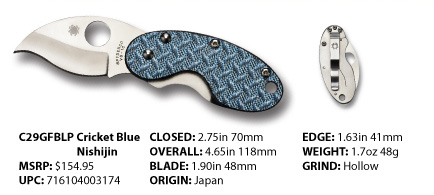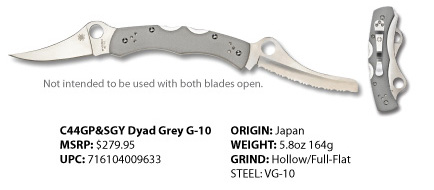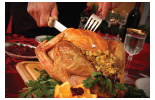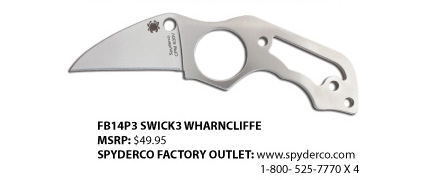
|
|||||||||||||

|

Glass fiber manufacturing is part chemical, part mechanical. Strands of glass and carbon are drawn into fibers thinner than a human hair and heated to high temperatures to expel the majority of non-carbon atoms in a process called carbonization. This process creates tightly woven chains of glass/carbon that when laminated into sheets makes exceptional knife handles that are lightweight, visually pleasing and wear-resistant. Our Japanese makers have developed a new weaving process for the fiber that creates a unique geometric, swirled pattern called Nishijin, a name that refers to a specific weave pattern used in producing silk Kimono cloth. The patterned handle scales add an attractive, three-dimensional appearance to any knife. The new C29GFBLP Blue Nishijin Cricket starts with the classic stainless Cricket CLIPIT and overlays the front with a blue Nishijin glass fiber scale. All Crickets are ergonomically shaped with a rounded profile much like a river rock worn smooth by water. On the back side of the handle is a stainless R.I.L. Chris Reeve Integral Lock designed by custom knifemaker Chris Reeve. He advanced Michael Walker’s LinerLock™ design by utilizing the knife’s steel handle scale as the lock bar that locks the blade in the open position. Integral locks eliminate the necessity for internal handle liners and allow a folder to be manufactured with a slim and exceptionally strong profile. The hollow-ground blade is under two inches and made of high-moly VG-10 stainless steel. It comes shaped like a reverse letter “S” and has a prominent curving tip that excels in detailed and fine cutting, even at craft projects. The Nishijin Cricket comes with a PlainEdged™ blade that incorporates the Spyderco Trademark Round Hole™ for simplified one-hand opening. A favorite among women and men alike, the Cricket is small and lightweight with loads of personality and cutting power. |
||||||||||||

|
|||||||||||||

|
GET 'EM BEFORE THEY'RE GONE! 
When most people think of traditional pocketknives, they see small gentlemen’s multi-bladed folders that float in the bottom of a pocket among “typically pocketed items” such as car keys, lint and change. Spyderco changed the concept of the traditional pocket folding knife with the introduction of the CLIPIT folder in the 1980s. CLIPITS are different in that they open using one-hand, carry in a pocket via a clip and offer the option of serrations on a folding knife blade. The CLIPIT design philosophy went a step further in the 1990s with the design of the Spyderco Dyad, a 2-bladed CLIPIT. Released in the 1990s the first Dyad had a multiple-year run and was discontinued. At our customer’s requests we are temporarily reviving the model and releasing a Sprint Run Dyad with a grey G-10 handle. The C44GP&SGY Dyad folder includes two full-sized VG-10 blades; one is a hollow-ground Sheepfoot-profile with a full-length SpyderEdge™. The second is a flat-ground clip-point blade with a thin cutting edge. The Sheepfoot’s serrations voraciously separate fibrous materials such as rope and line, while the PlainEdge blade makes short work when intricately and precisely cutting. Combined, the blades provide more than 6-inches of cutting power and each blade locks open independently with a its own Michael Walker LinerLock. Spyderco further refines the folder by pairing the superior blades with a grey G-10 handle and a satin finished four-way pocket clip. If the Dyad’s past popularity is any indication, the Dyad Sprint Run will please both knife users and collectors alike, and it is available in limited numbers for a short time only. |
||||||||||||

|
|||||||||||||

|
UNDERSTANDING THE STATE-OF-THE-ART IN NON-LOCKING FOLDERS 
Although their exact history is unclear, the earliest known folding knives date back to the Roman Empire around 600-500 B.C. Consisting of simple blades that folded into crude handles, early folding knives had no locks and remained open during use only by the friction of the joint mechanism. Centuries later, these “friction folders,” as they are now known, evolved to become more refined, safer, and more reliable. One of the primary improvements to their design was the addition of a tab that extends from the tang of the blade, much like the extended tang of a traditional straight razor. In the open position, this tab lays against the back of the handle and acts as a stop to restrict the opening arc of the blade. When the knife is gripped in the hand, pressure from the user’s grip holds the tab in place to keep the blade from closing during use. When the knife is closed, the tab protrudes from the front of the handle and can also be used as a lever to help open the blade. As folding knives and metallurgy evolved, knifemakers began to incorporate mechanical elements into their designs to hold the blade in the open position. This gave rise to the most common form of non-locking folding knife: the slipjoint. The defining characteristic of a slipjoint knife is the inclusion of a flat spring in the back of the handle. This spring applies constant pressure against the tang of the folding blade, which features a flat spot on the edge side and a shouldered flat spot on the spine side. In the closed position, the spring’s pressure on the edge-side keeps the blade safely closed. When the blade is opened, the shoulder of the tang contacts the front of the spring and acts as a stop. The spring’s pressure on the flat area of the tang adjacent to the shoulder holds the blade open and allows it to be safely used for most cutting chores. Perfectly suited to the vast majority of cutting tasks, slipjoints are socially acceptable and legally permissible almost everywhere. Spyderco’s expressions of the slipjoint concept include our Trademark Round Hole™, which not only makes them instantly recognizable as members of the Spyderco family, but is also much more user friendly than a traditional nail nick for two-handed opening of the blade. Spyderco’s SLIPIT™ knives integrate an improved notched-joint pivot mechanism, a pocket clip for convenient carry, and one-handed opening operation via our Trademark Round Hole. These knives represent a significant evolution of slipjoint design and bring the non-locking folder into its own as a modern everyday carry cutting tool. SLIPITS also feature an index finger choil that provides a comfortable purchase for the index finger during use and help prevent accidental closure of the blade. Spyderco’s non-locking folders redefine the state-of-the-art in knifemaking tradition and provide knife users worldwide with cutting tool options that are legally permissible and socially acceptable. |
||||||||||||

|
|||||||||||||

|
|
||||||||||||

|
   
|
  
|

|


